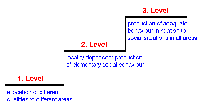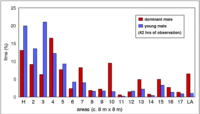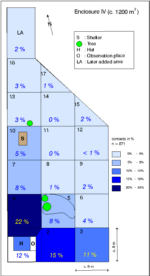|
|
 |
Abstract Ethological Conference Tübingen August 2001
Introduction
Subdominant animals in groups of mammals live under a continuous strain due to the presence of dominant individuals. They are suppressed in different ways and have to develop an ability to cope with this, using the space remaining in their specific situations to generate well-being and to develop their species specific behaviour. In our enclosures sexually mature young muntjacs are often harassed or even attacked by the dominant adult of their sex. This situation can build up to a point where it becomes impossible for the young animal to continue living in this group. In many cases however the young subdominant animal adapts to its situation and learns to live without excessive stress together with the dominant conspecifics.
The main issue of the study is this situation of a subdominant young animal: Which spatial and social mechanisms does it use and which abilities are required and developed? Which internal states are involved and to what extent are the performances individually shaped?
Main methods and basic earlier findings
Studied are breeding groups of three to seven Chinese muntjacs of different ages, kept in enclosures of 2,000 - 3,000 m2. About 80 defined behavioural units are recorded and the data are used to assess the performance of the subdominant animals in arranging their life in their situation, maintaining their well-being under the dominant animal of the same sex. Main parameters include the development of spatial and social attachments, the generation of adequate internal states for the production of effective behaviour, and the development of the species specific skill in coping with changing and with new situations. |

Fig. 1: Levels of behavioural organisation: steps in the development of social competence in the young male muntjac |

Fig. 2: Space use of the dominant and the young male in enclosure IV |
In a preceding study a simple model (Fig. 1) has been designed to describe and to analyse the different influences of the various factors. The model distinguishes three main levels: On the first level different qualities are allocated to different areas of the enclosure. Of major importance is a place to where the animal can retreat without being disturbed and harassed by a dominant animal. This is an elementary condition for its further behavioural development. |

Fig. 3: Spatial distribution of active social contacts to the two females by the subdominant male in enclosure IV |
On the second level this space is linked to the production of specific social behaviour. On the third level the animal learns to employ the acquired skill in orientation and behaviour in the various social situations in all areas of the enclosure. For an illustration two simple patterns are given. Figure 2 shows the different use of space by the two bucks living in one group. Figure 3 shows that most contacts to the does (marking, licking, sniffing and even mounting) by the subdominant buck took place in his preferred areas. The dominant buck used the whole enclosure more evenly. The subdominant buck showed a significant preference for just a few areas. In these it is possible for him to relax, i.e. to ruminate or to calm down after coping with difficult situations. This can lead to an internal state in which he again is able to start exploring, to contact one of the does, or even the dominant buck in a calm situation. |
Aims of the present study
The main task of the present study is to collect data on a larger basis to test with a multidimensional correlating analysis the suitability of the model. The following data have been collected (in nearly 400 hrs of observation): The use of the spatial areas for all group members: time budget (duration of stay), different forms of activities (i.e. feeding, marking, resting, play) and the different indicators (postures and movements of body, ears, eyes, legs and tail) of the internal states (e.g. affective and motivational states as well as levels of arousal, tension and security). The interactions of the subdominant animals with all other group members have been recorded in comparable detail.
Some of the preliminary results can be summarized as follows: The degree of well-being shows in the extent to which a subdominant individual is able to keep its own orientation, to generate own intentions and to produce and to continue the respective behaviours. Basic conditions for the ability of a subdominant individual to maintain a status of well-being include the following two:
- a place of retreat, situated in its preferred area of the enclosure, at which it is able to loose exessive arousal and tension, to relax and to regenerate; such places have in common the following attributes:
- they provide cover (for hiding and weather protection),
- they allow a view over the surrounding area,
- they are not frequently used by dominant animals,
- the animal develops a special attachment to this place; this place of retreat can change with seasons and with major social occurrances (birth, change in dominance order), it is known by the dominant animal which accepts the different behaviour of the subdominant at this place
- comparable effects on the subdominant animals in addition to this place of retreat can have a friendly relation to an individual conspecific of the group (usually of lower rank and often of the opposite sex): the contacts required to first develop and then to maintain such a relation provide means to generate internal states relevant for well-being; in proximity to this attached individual for example the subdominant animal can withstand the (friendly) approach of the dominant animal.
Intended additional research
- heartbeat telemetry
- observation of freeliving muntjacs in England
Possible areas of application
- raising captive animals
- managing freeliving populations
- diagnosing and improving quality of well-being in captive and in freeliving animals
|
 |
|

